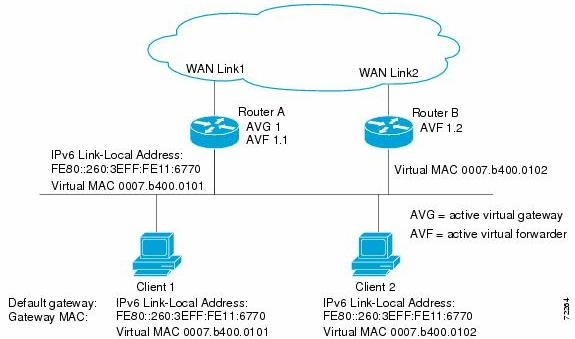Refer to the exhibit. Which four statements accurately describe this GLBP topology? (Choose four.)


A.
Router A is responsible for answering ARP requests sent to the virtual IP address.
B.
If Router A becomes unavailable, Router B will forward packets sent to the virtual MAC address of Router A.
C.
Router A alternately responds to ARP requests with different virtual MAC addresses.
D.
Router B will transition from blocking state to forwarding state when it becomes the AVG.
E.
If another router were added to this GLBP group, there would be two backup AVGs.
F.
Router B is in GLBP listen state.
Explanation:
With GLBP the following is true:
With GLB, there is 1 AVG and 1 standby VG. In this case Router A is the AVG and Router B is the standby. Router B would act as a VRF and would already be forwarding and routing packets. Any additional routers would be in a listen state. As the role of the Active VG and load balancing, Router A responds to ARP requests with different virtual MAC addresses.
In this scenario, Router B is the Standby VF for the VMAC 0008.b400.0101 and would become the Active VF if Router A were down.
As the role of the Active VG, the primary responsibility is to answer ARP requests to the virtual IP address.
As an AVF router Router B is already forwarding/routing packets


Wrong answer E.
If another router were added to this GLBP group, there would be two backup AVGs. ( There is no backup AVG, only Active or Standby)
Right answer F.
Router B is in GLBP listen state (waiting for the active or standby AVG to fail)
0
0
How can B be in listen state? it is in standby state, since its the backup AVG.
If there was an third router added it would be in listening state.
F is correct since it just states there will be another router that can take over the AVG role(an backup). It doesn’t say anything about the actual AVG state on the new router.
0
0
I can’t find 4 correct answers here.
Only A, B and C are correct.
D is nonsense.
E is incorrect because there is no “backup” state on GLBP. It is trying to mess the head of the test taker by referencing the Backup state of HSRP.
F is not correct because router B is in standby state. There are only 3 states in GLBP: Active, Standby and Listen. With only two routers present on the topology, there will not exist a router in listen state. Just an active and a standby.
0
0
how to decide weather the 4th answer will be E or F when we face it in real exam.
0
0
Ithink other
0
0
I think last one is D: Router B will transition from blocking state to forwarding state when it becomes the AVG.
remember it is GLBP it can Simultaneously transmit packge out to gateway is we see standby is backup than should only have one backup but the third one add in can be use as load balance or the second backup incase RB fail
0
0
Correct Answer: A,B,C and E.
A,B,C are pretty much straight forward.
‘E’ being correct because the answer says “If another router were added to this GLBP group, there would be “two backup AVGs”.”
By saying two backup AVG’s it means two backup routers for present AVG (Router A in this case). So if another router is added to the present GLBP group of two routers, there would be two backup routers backing up the present Active Virtual Gateway(Router A).
F is not correct because the third/fourth router in the group would go into listen state, Router B would stay in Standy state.
D doesn’t make sense because Router B isn’t in blocking state, it is sharing the load with Router A by forwarding packets sent to its VMAC.
0
0
I agree with Hussain. AVFs are indeed called BackupAVGs and there can be a maximum of 4 of them. Therefore, E is correct, along with A, B and C.
0
0